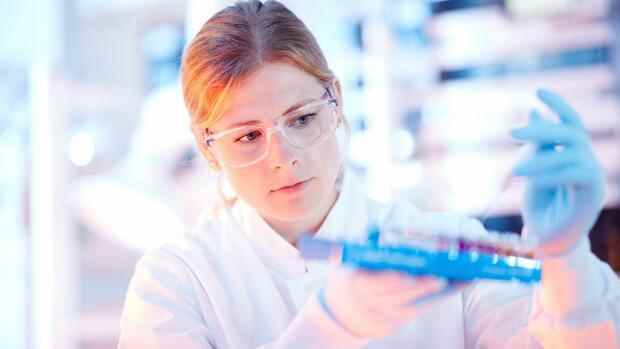Frankfurt After several important advances in product development, the pharmaceutical group Boehringer Ingelheim sees itself at the beginning of a new investment offensive in the area of product development and production. To this end, the group intends to increase both its research expenditure and capital expenditure by a good quarter over the next few years compared to the previous level.
Overall, Boehringer plans to spend more than EUR 25 billion on research and significantly more than EUR 7 billion on new fixed assets over the next five years. The Ingelheim-based company expects additional impetus in the next few years from new therapies for heart failure, pulmonary fibrosis, inflammatory skin diseases and schizophrenia.
In addition, Boehringer hopes to make progress in cancer therapy with innovative products, including a new immunotherapeutic agent.
Based on the latest advances in research, company boss Hubertus von Baumbach sees opportunities for up to 15 product launches by the middle of the decade. He sees the fact that the American approval authority FDA classified four of Boehringer’s development products as potential therapy breakthroughs, including the active ingredients against schizophrenia and pulmonary fibrosis, as a decisive success of the past year. “This is a seal of quality for what we do in terms of innovation and in this respect also a confirmation of our innovation strategy,” says von Baumbach.
Top jobs of the day
Find the best jobs now and
be notified by email.
With its business figures for 2021, the family company continues to present itself in a solid, relatively steady and financially strong upward trend. The group’s sales increased by 5.4 percent to 20.6 billion euros and thus exceeded the 20 billion mark for the first time. Factoring out negative currency effects, the business grew by 7.5 percent, according to the company. For the current year, however, Boehringer expects only a slight increase in sales on a comparable basis.
Two percent more profit
The company increased its operating profit (EBIT) by a good two percent to 4.7 billion euros in 2021. After taxes, a net profit of 3.4 billion euros remained, an increase of eleven percent compared to the previous year. For the Ingelheim group, these results are consistently new peak values. Free cash flow of around 2.7 billion euros also made it possible to further strengthen the Group’s already ample financial reserves to around 15 billion euros.
With 4.2 billion euros, the company has the largest R&D budget in the German pharmaceutical industry.
(Photo: obs)
The main pillar of Boehringer is still the human pharmaceuticals division with sales of EUR 15.3 billion and 8.4 percent currency-adjusted growth, followed by the animal medicines business with sales of EUR 4.3 billion and 6.2 percent growth and the biopharmaceutical contract manufacturing area, the 915 million euros (plus 9.5 percent) contributed to group sales.
This makes Boehringer by far the largest pharmaceutical manufacturer that is still fully owned by the founding family. Measured in terms of human pharmaceutical sales, Boehringer is currently the third-largest drug manufacturer in Germany after the Mainz-based biotech climber Biontech and the Bayer group.
As far as research spending is concerned, Boehringer has the largest R&D budget in the German pharmaceutical industry at 4.2 billion euros. In 2021 alone, spending increased by around 500 million euros. The further increase results above all from planned larger phase 3 studies with the promising products in the development pipeline. In addition, according to Baumbachs, the company intends to continue investing heavily in digitization. For example, Boehringer is working with the US company Alphabet in the field of quantum computing with the aim of using this technology in research in the future.
Despite the high R&D expenditures in recent years, Boehringer has not been able to come up with a large number of new registrations in product development. However, extensive clinical studies have significantly strengthened the potential of several new developments from the past decade.
Diabetes drug is the most important growth driver
First and foremost, this includes the diabetes drug Jardiance, which with sales of 3.9 billion euros (up 28 percent) is already the most important growth driver for Boehringer. It recently received approval for heart failure and has also shown good results when used to treat kidney disease. According to some analysts, sales could almost double again in the next few years.
The fibrosis drug Ofev has established itself as the second strongest product with sales of EUR 2.5 billion (up 25 percent). With these top products, Boehringer was able to more than compensate for the double-digit drop in sales of older products such as the respiratory drug Spiriva.
Another important growth driver for the result, if not the sales of the group, is the psoriasis drug Skyrizi, with which the US pharmaceutical company and licensee Abbvie achieved sales of around three billion dollars and very high growth last year.
Also read:
In the current year, as Abbvie boss Richard Gonzalez recently announced, the US pharmaceutical company is expected to transfer around one billion dollars (about 900 million euros) in license fees for Skyrizi to Boehringer. This income will flow into the operating result on a one-to-one basis and is likely to continue to rise in the coming years.
Boehringer now hopes to achieve further success in immunology with the active substance spesolimab, which is now in the approval process as a therapy for a special type of psoriasis and is also being tested for various other immunological diseases.
As far as future expansion in research is concerned, Boehringer continues to rely primarily on its own development capabilities, supplemented by alliances. Despite the high financial reserves, large acquisitions in the pharmaceutical sector are not an issue in Ingelheim, as von Baumbach makes clear. He doesn’t completely rule out smaller acquisitions. “But we remain true to ourselves and will only invest where it really makes sense, i.e. in the early research phases,” said von Baumbach.
More: Curevac starts clinical trial with improved Covid-19 vaccine
